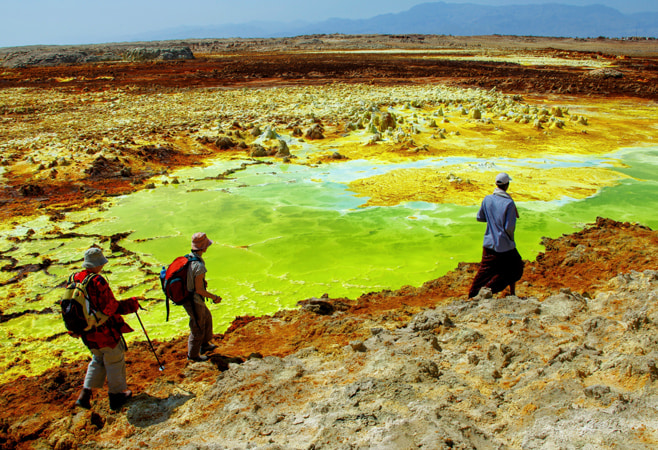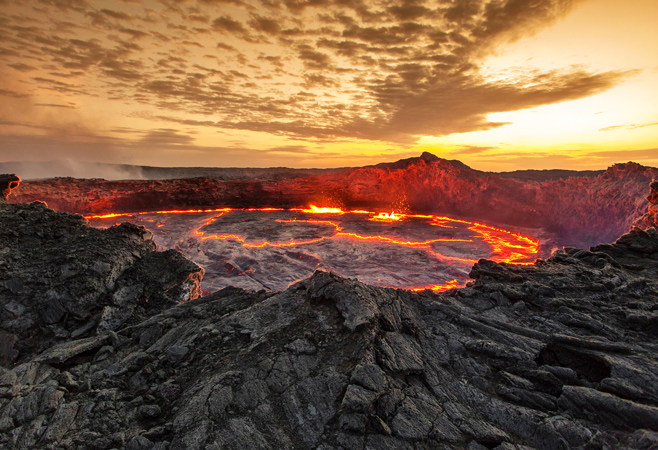Top Active Volcanoes in Ethiopia You Must See
Ethiopia, known for its ancient culture and stunning highlands, is also home to some of the world’s most spectacular active volcanoes. These geological marvels are part of the East African Rift System, where the African continent is slowly splitting apart — creating a landscape unlike anywhere else on Earth.
For adventure seekers, witnessing Ethiopia’s active volcanoes is an unforgettable experience. From glowing lava lakes to surreal salt plains, these destinations promise raw natural beauty and thrilling encounters with one of nature’s most powerful forces.
 Dallol’s vibrant hydrothermal pools with bright yellow, green, and orange mineral deposits
Dallol’s vibrant hydrothermal pools with bright yellow, green, and orange mineral deposits
Why Ethiopia's Volcanoes are a Unique Travel Destination
Visiting these sites is more than a hike; it is an expedition into an environment that feels more like another planet.
Witness a living planet: See glowing lava lakes, bubbling sulfur springs, and steaming fumaroles.
Unique landscapes: Black lava fields, turquoise acid lakes, and rainbow-colored mineral deposits.
Low tourist crowds: Far less visited than Iceland or Hawaii, offering authentic adventure.
Cultural fusion: Meet Afar nomads who live alongside these volcanic forces.
Top Active Volcanoes to Visit in Ethiopia
Within this rift, several volcanoes remain active, offering scientists and travelers a rare opportunity to study and experience Earth’s fiery energy firsthand. The most famous of these is Erta Ale, known worldwide for its continuously bubbling lava lake.
1. Erta Ale Volcano – The “Gateway to Hell”
- Location: Afar Region, northeastern Ethiopia
- Elevation: 613 meters (2,011 ft)
- Activity: Continuously active
Erta Ale is famous for its long-lived lava lake, although in recent years the activity has fluctuated and the lava lake is not always visible. Located in the Danakil Depression, one of the hottest and driest places on Earth, Erta Ale’s fiery glow illuminates the desert night sky, creating a surreal and almost otherworldly scene.
Most current tours start from Semera, as access from Mekele has been limited in recent years and involves a rugged drive and a nighttime hike to avoid the extreme heat. At the summit, visitors are rewarded with the mesmerizing sight of molten lava swirling inside the caldera.
This is a must-visit for adventurous travelers looking to experience the Earth’s raw energy up close. However, proper preparation and local guidance are essential due to the harsh environment.
Travel Tip: Always join a licensed tour with local guides who understand the desert terrain and safety protocols. And before your trip, apply for your Ethiopia e-Visa to simplify entry through Addis Ababa Bole International Airport, the main arrival point for visitors.
 Tourists visit the black lava fields on the way to Erta Ale’s summit
Tourists visit the black lava fields on the way to Erta Ale’s summit
2. Dallol Hydrothermal Field – One of the Hottest Places on Earth
- Location: Danakil Depression, Afar Region
- Elevation: -130 meters below sea level
- Activity: Hydrothermal (fumarolic activity)
While not a traditional lava-spewing volcano, Dallol is one of the most extraordinary active volcanic areas in Ethiopia. Situated in the Danakil Depression, Dallol features colorful hydrothermal fields, acid pools, and sulfur springs that paint the landscape in vivid shades of yellow, green, and orange.
Temperatures here can exceed 45°C (113°F), making it one of the hottest regions ever recorded on Earth. The terrain looks almost alien — so much so that NASA has compared it to environments on Mars.
Visiting Dallol is a photographer’s dream but requires careful planning. The area is remote and best visited with organized tours departing from Mekele, typically combined with a trek to Erta Ale.
Did you know? Dallol’s bright yellow salt crusts and steaming vents result from volcanic heat interacting with underground salt and minerals.
Before planning your trip to Dallol, don’t forget to secure your Ethiopia e-Visa online — it’s the easiest way to enter the country and begin your adventure without delays.
3. Mount Fentale – The Volcano Overlooking the Rift Valley
- Location: Awash National Park, Oromia Region
- Elevation: 2,007 meters (6,585 ft)
- Activity: Dormant but thermally active
Located near Awash National Park, Mount Fentale is a striking stratovolcano that last erupted in the early 19th century. The volcano offers breathtaking panoramic views of the Awash River Gorge and surrounding savannas teeming with wildlife.
Travelers can hike up the mountain, exploring volcanic cones, lava flows, and geothermal vents. It’s an ideal destination for those seeking a mix of volcanic landscapes and wildlife safaris — all within a few hours’ drive from Addis Ababa.
Combine your hike up Mount Fentale with a visit to the nearby Awash Hot Springs for a rejuvenating experience.
Ensure your entry is approved in advance by applying for the Ethiopia e-Visa before departure.
 Camels walking through the harsh desert terrain of the Danakil Depression
Camels walking through the harsh desert terrain of the Danakil Depression
4. Aluto Volcano – Home of Hot Springs and Crater Lakes
- Location: Between Lake Langano and Lake Ziway, Rift Valley
- Elevation: 2,325 meters (7,628 ft)
- Activity: Active geothermal system
Aluto Volcano, also known as Aluto-Langano, is a large volcanic complex famous for its geothermal activity, fumaroles, and hot springs. It’s an important site for Ethiopia’s renewable energy development, housing the country’s first geothermal power plant.
For travelers, the Aluto area is a peaceful destination where you can explore scenic lakes, soak in hot springs, and enjoy birdwatching. It’s easily accessible from Addis Ababa, making it one of the more convenient active volcano sites to visit.
Insider Tip: Visit in the early morning for the best light and fewer crowds.
Remember, before your trip, apply for your Ethiopia e-Visa to make your arrival process effortless.
5. Nabro Volcano – Ethiopia’s Remote Giant
- Location: Afar Region, near the Eritrean border
- Elevation: 2,218 meters (7,277 ft)
- Activity: Erupted in 2011
The Nabro Volcano gained international attention during its 2011 eruption, which sent ash plumes over the Red Sea and affected air travel across East Africa. Though less accessible to tourists due to its remote location, Nabro remains an important active volcano for scientists studying the East African Rift’s dynamics.
Due to its remote location and restricted access near the Eritrean border, Nabro is generally not open for regular tourism and is mainly visited by researchers with special permits. Access typically requires special permits and coordination with local authorities.
When to Visit Ethiopia’s Volcanoes
The best time to explore Ethiopia’s active volcanoes is during the dry season (October to March). During this period, the weather is more manageable, especially in the Afar region, where temperatures can soar year-round.
Make sure to:
- Travel with experienced guides who are familiar with desert and volcanic terrain.
- Bring light, breathable clothing, sturdy shoes, and plenty of water.
- Obtain all necessary travel permits (especially for Erta Ale and Dallol).
- And most importantly, ensure your travel documents are in order by applying for your Ethiopia e-Visa well before your departure.
 Fumaroles releasing gas near the Dallol crater, creating surreal lunar-like scenery
Fumaroles releasing gas near the Dallol crater, creating surreal lunar-like scenery
Travel Tips for Volcano Exploration
Join a licensed tour operator: Volcano treks require expert guidance, especially in remote areas like the Danakil Depression.
Physical Fitness: A moderate level of fitness is required for the nighttime trek up Erta Ale.
Pack for extreme conditions: Temperatures can exceed 40°C (104°F), and terrain is rugged.
Pack lightweight, protective clothing, and hydrate constantly.
Safety: Always follow the instructions of your experienced local guides and security personnel.
Respect local customs and safety protocols: Many volcanic sites are near indigenous communities and sensitive ecosystems.
Why Visit Ethiopia’s Active Volcanoes?
Visiting Ethiopia’s volcanoes offers a unique mix of adventure, science, and natural beauty.
Erta Ale delivers one of the few chances in the world to see an open lava lake.
Dallol immerses travelers in a Martian-like landscape of color and heat.
Mount Fentale and Aluto combine volcanic scenery with wildlife and hot springs.
These sites reveal Ethiopia’s raw geological power and its incredible diversity of landscapes — from highland mountains to the lowest, hottest depression on Earth.
Apply for Your Ethiopia e-Visa Today
Before embarking on your volcanic adventure, simplify your travel arrangements by applying for your Ethiopia e-Visa online. The official e-Visa portal allows travelers to:
- Apply from anywhere in the world
- Receive approval quickly via email
- Skip long lines at immigration upon arrival
Apply now to Ethiopia Immigration Services and get ready to explore Ethiopia’s active volcanoes — where the Earth’s fire meets breathtaking natural beauty.
Conclusion
Ethiopia’s active volcanoes offer an extraordinary journey through one of the planet’s most geologically fascinating regions. Whether you’re standing beside the molten lake of Erta Ale, photographing the vivid landscapes of Dallol, or hiking the slopes of Mount Fentale, each experience connects you to the raw forces that shape our world.
Before setting off on this fiery expedition, ensure a smooth travel experience by applying for your Ethiopia e-Visa. The process is quick, convenient, and essential for anyone planning to explore Ethiopia’s volcanic wonders.
Related Articles
- Experiencing the Ethiopian Coffee Ceremony as a Visitor
- Exploring Dorze Village: What to See and Do
- Top Travel Apps for Visiting Ethiopia
- Top Destinations for Historic Holidays in Northern Ethiopia
- Ethiopia Entry Requirements for African Travelers
- Bole Addis Ababa International Airport: What Travelers Need to Know
- Exploring the Gheralta Rock Churches of Ethiopia
- Ethiopian Highlands Travel Tips: Things Must See & Do
- Travel From Eritrea to Ethiopia: What Tourists Need to Know





